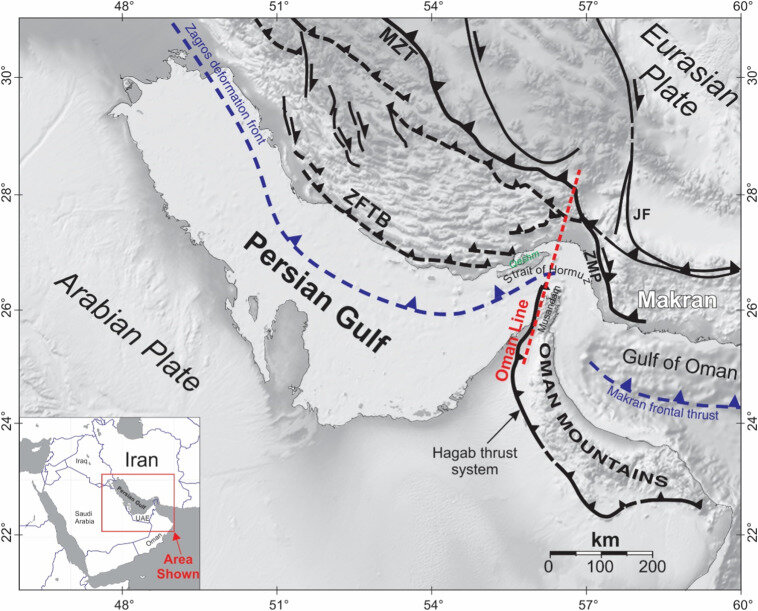Role of oil and gas extraction by Saudi Arabia and Qatar in southern Persian Gulf earthquakes
Role of oil and gas extraction by Saudi Arabia and Qatar in southern Persian Gulf earthquakes
TEHRAN - Seven earthquakes with magnitudes between 4 and 5 in the southern Persian Gulf and the Saudi Arabia-Qatar border between 1st of March and 5th of April 2025 probably represent links between hydrocarbon extraction and seismicity due to the generation of earthquakes due to oil and gas production near an active basement fault in the Saudi-Qatar border area.

Hydrocarbon extraction for oil and gas production can alter subsurface stress fields and potentially reactivate faults.
The Arabian plate experienced significant seismic activity between 2024 and 2025, influenced by its tectonic interactions with the Eurasian, African (Nubian), and Indian plates.
The Arabian Plate is moving northeast (~1.5-2 cm/yr) and collides with Eurasia, forming the Zagros Mountains, and slides westward along the Dead Sea Transverse Fault (DST) past the African Plate.
Subduction occurs beneath the Makran Range (southern Iran/Pakistan), and opening occurs in the Red Sea and Gulf of Aden.
Deep faults in the crystalline basement rock (in the Arabian Plate) are sensitive to changes in stress. This region lies on the Arabian Plate and has underground faults related to the Zagros orogeny and the Red Sea rifting.
The Ghawar Hydrocarbon Field (Saudi Arabia) and the Shemal Gas Field (Qatar) are among the largest hydrocarbon reservoirs in the world. Some of the faults in the region are highly stressed, meaning that even small changes in pressure can trigger slip.
Seven earthquakes in March-April 2025 Increased production/injection with increased extraction or wastewater disposal (e.g., from fracturing or increased oil recovery) destabilizes an adjacent fault.
If operations occur near a strike-slip or reverse fault, stress transfer can trigger moderate earthquakes (M4-M6). Sometimes, induced earthquakes occur months or years after operations begin due to gradual stress changes.
There have been no major documented cases of moderate earthquake-induced seismicity reported in Saudi Arabia/Qatar, but there is a risk of induced seismicity when exploration and extraction operations interrupt stressed faults.
Mild to moderate earthquakes (M3-M5): Can damage infrastructure, pipelines or offshore platforms. Larger earthquakes (M6+): Possible if a major bedrock fault reactivates, posing a risk to cities such as Dammam or Doha.
While the Saudi Arabia-Qatar region has not yet experienced major earthquakes, the combination of active subsurface faults and intense hydrocarbon activity increases this risk. The events in March-April 2025 were plausible if production/injection operations were to disrupt a critical stress fault. Monitoring and risk assessment are critical to prevent such scenarios.
The tectonic seismic framework of eastern Saudi Arabia, Qatar, and Bahrain is characterized by complex interactions between multiple tectonic plates, primarily the Arabian Plate and the surrounding Eurasian and African Plates. The region experiences seismic activity due to its geological location involving major fault systems and oil and gas production activities.
The eastern Saudi Arabia region, including Qatar and Bahrain, lies along the Arabian Plate boundary. The Arabian Plate is moving northward relative to the Iran-Eurasian Plate at a rate of approximately 20 mm/yr. This movement results in compressive forces that generate seismic activity in the region.
The region is cut by important fault systems, such as the Dead Sea Transverse Fault on the western border to the north and various strike-slip faults associated with the Zagros Mountains to the northeast. These faults accommodate movement between plates. Earthquakes in this region can be attributed to both natural tectonic processes and anthropogenic factors associated with oil extraction activities.
The region is characterized by several important geological features, including active basement faults that play an important role in the tectonic and seismic behavior of the region.
In the Eastern Province of Saudi Arabia Several smaller but important faults have been identified. The Al-Hasa Fault is located near Al-Hasa Oasis and has been associated with historical seismic events.
The Qatif Fault, located near Qatif, has shown signs of activity and may affect local seismicity. The Qatar Arc is a structure that affects the subsurface geology of Qatar. The formation of this structural arc, which is part of the larger Qatar-Kazerun basement structure, results in localized stress concentration along existing faults.
Earthquakes often occur in clusters or sequences due to stress accumulation along these faults. Historical records indicate that while large earthquakes are relatively rare, smaller tremors are common due to ongoing tectonic processes.
Historical data indicate that earthquakes in this region often occur in clusters or sequences rather than as isolated events, indicating a complex interaction between local geological structures.
Hydrocarbon extraction in eastern Saudi Arabia is associated with induced seismicity.
Oil extraction processes can lead to changes in subsurface pressure conditions, potentially triggering and triggering small earthquakes. Seismic events have been recorded near major oil fields such as Ghawar, where fluid extraction may affect local stress conditions.
The Saudi Arabian Geological Survey and Iranian Seismic Network actively monitor seismic activity in Oil production areas. Data from these monitoring efforts show a correlation between periods of intense hydrocarbon extraction and increased seismic events. Earthquakes in this zone raise concerns about the safety of infrastructure and the long-term sustainability of oil production practices in this seismically active region.
The tectonic structure of eastern Saudi Arabia, Qatar, and Bahrain is shaped by complex plate interactions that result in significant seismic activity driven by natural tectonic processes and anthropogenic factors resulting from oil and gas production. Continuous monitoring is essential to understand these dynamics and mitigate the risks associated with seismic hazards in this economically vital region.
source: tehrantimes.com